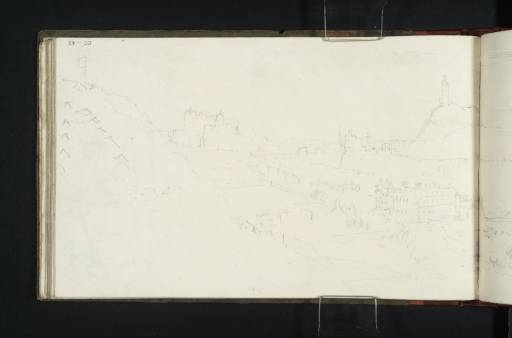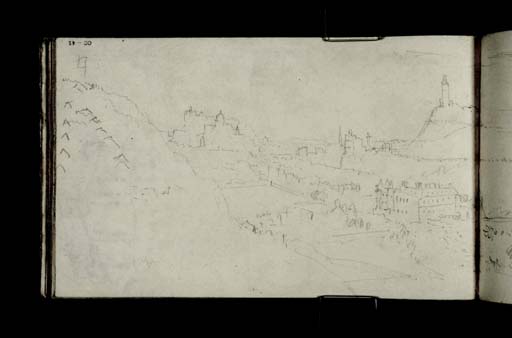Joseph Mallord William Turner Edinburgh from Arthur's Seat: A Procession Towards Holyrood 1822
Image 1 of 2
Joseph Mallord William Turner,
Edinburgh from Arthur's Seat: A Procession Towards Holyrood
1822
Joseph Mallord William Turner 1775–1851
Folio 41 Recto:
Edinburgh from Arthur’s Seat: A Procession Towards Holyrood 1822
D17574
Turner Bequest CC 41
Turner Bequest CC 41
Pencil on white wove paper, 114 x 187 mm
Inscribed in pencil by Turner ‘water’ centre
Inscribed in red ink by John Ruskin ‘41’ (very faint) top left inverted
Stamped in black ‘CC 41’ top left inverted
Inscribed in pencil by Turner ‘water’ centre
Inscribed in red ink by John Ruskin ‘41’ (very faint) top left inverted
Stamped in black ‘CC 41’ top left inverted
Accepted by the nation as part of the Turner Bequest 1856
References
1909
A.J. Finberg, A Complete Inventory of the Drawings of the Turner Bequest, London 1909, vol.I, p.611, CC 41, as ‘View of Edinburgh, from St. Anthony’s Chapel – “17 windows 8 attics, &c.” (probably referring to Holyrood); also “Carline Park”, &c.’.
1975
Gerald Finley, ‘J.M.W. Turner’s Proposal for a “Royal Progress”’, The Burlington Magazine, vol.117, January 1975, p.32 note 26.
1981
Gerald Finley, Turner and George the Fourth in Edinburgh 1822, exhibition catalogue, Tate Gallery, London 1981, pp.83, [143] reproduced as View of Nelson’s Monument on Calton Hill, from Elm Row and Blenheim Place, looking up Antigua Street to the triumphal arch shown from the other direction on pp.39a–40; “Caroline Park”, “17 windows 8 attics” (this probably refers to Holyrood); Holyrood from St Anthony’s Chapel, with the King’s carriage and procession going to or coming from the review at Portobello Sands.
1981
Eric Shanes, Turner’s Rivers, Harbours and Coasts, London 1981, p.152.
To make this view, continued on folio 40 verso (D17573), and drawn with the sketchbook inverted, Turner stood at the foot of Arthur’s Seat above St Margaret’s Loch and looked west out over the city of Edinburgh. Arthur’s Seat rises above him to the left with a flag at its western summit. Halfway down the hill in the lower centre of folio 41 are the ruins of St Anthony’s Chapel. Straight ahead at the right of the present page is the Palace of Holyrood with the Abbey drawn across the join of the two pages. There is a view of Holyrood Palace from the opposite direction on folio 37 of this sketchbook (D17566).
As Gerald Finley has pointed out, the inscription at the centre of folio 40 verso, ‘17 windows 8 attics’, refers to Holyrood with its three storeys of seventeen windows on its eastern façade and eight dormer windows in its roof. The inscription ‘Pilbox’ probably refers to some small box-shaped feature.1 There is a row of houses to the left of Holyrood where the Scottish Parliament now stands, and the inscription ‘water’ probably refers to a small loch. Nelson’s Monument stands behind Holyrood House at the summit of Calton Hill with Calton Gaol at its western foot. Either side of the Governor’s House (see Tate D13434; Turner Bequest CLXV 61a) are the spire of St Andrew’s Church and the column of the Melville Monument. The old North Bridge stands at the centre of the page, and to its left are the outlines of St Giles’s Cathedral and Edinburgh Castle. The view continues on folio 40 verso with the eastern half of Calton Hill, Holyrood Abbey and houses on Abbey Hill, and in the foreground is a path crossing St Ann’s Yards, now Holyrood Park.
Finley has regarded this drawing as the ‘King’s carriage and procession going to or coming from the review at Portobello Sands’ on 23 August 1822.2 The procession itself is rather obscure and is secondary in the picture to the topography. A series of small vertical dashes along and at the bottom of Calton Hill suggest a line of people snaking around the hill’s paths, and there are similar dashes clustered around the entrance to Holyrood House. At the bottom of folio 40 verso are a series of scribbles including two circles that can clearly be identified as a cart or coach. It is presumably this that Finley regarded as the King’s ‘carriage’. The procession therefore seems to come from Regent Bridge, up and around Calton Hill before turning west to enter the grounds of Holyrood.
Finley’s identification was reached perhaps more through a process of elimination than by any strong evidence for this particular event. According to Robert Mudie and John Prebble, George IV went straight from Dalkeith (where he stayed throughout the visit) to Portobello and returned directly afterward.3 It would be an illogical route that took the king via Holyrood and Calton Hill on his way. Furthermore, the journey to and from Portobello was not an event in itself, so Turner had no reason to make a record of it, and there are no sketches of the review so there is no evidence that he saw it. However, he did write the word ‘Review’ in the box for the 9th composition of his proposed ‘Royal Progress’ cycle (see the Inside back cover of the King at Edinburgh 1822 sketchbook; Tate D40980), suggesting that he thought of the event as worthy of a picture.
Other processions hold more obvious significance and pictorial interest. George IV’s procession into Edinburgh from Leith on 15 August took him to Holyrood via Calton Hill before he set off for Dalkeith.4 Basil Skinner writes about a painting by William Turner of Oxford of ‘The Procession passing Calton Hill’ and refers to ‘a small sketch from the same spot’ by J.M.W. Turner,5 which is presumably this one, though he does not specify that it is of the same event. Finley has also identified one of the ‘Royal Progress’ compositions (number ‘5’, Tate D40979; Turner Bequest CCI 43a) as The approach to Holyrood Palace (15 August), and he originally connected that composition to the present sketch,6 though he changed his mind in a later publication. Turner appears to represent the cavalcade descending the hill to the palace,7 though he does not link it with the present drawing. Though certainly possible, it is perhaps doubtful that Turner, who had stood on the pier at Leith watching and sketching the King’s landing on that day, would have been able to overtake the procession into Edinburgh in order to install himself on Arthur’s Seat in time to draw the arrival of the King’s carriage at Holyrood.
The other possibility is the King’s procession to the castle with the Regalia on 22 August. From Dalkeith he returned to Holyrood via Calton Hill.8 However, Turner was again installed elsewhere on this day – at the castle itself (see folio 36 verso; D17565) – and would have had to overtake the king in order to see him return from Arthur’s Seat. Furthermore, his numerous and detailed sketches from the castle that day indicate that this was his preferred approach to the subject. His ‘Royal Progress’ cycle composition ‘11’ and his eventual realisation of the subject as a title page vignette for volume 1 of the Provincial Antiquities and Picturesque Scenery of Scotland (Tate D13749; Turner Bequest CLXVIII B) both show the King’s arrival at the castle, though from the Esplanade rather than the battlements.
Gerald Finley’s suggestion is a compelling identification as there is nothing to directly contract it. However without further visual evidence alternative events must also be considered as possibilities.
Thomas Ardill
September 2008
Although the term ‘Pillbox’ was not commonly used to describe built structures until the First World War when they became the popular term for concrete gun emplacements, the Oxford English Dictionary cites examples of the term being applied – generally derogatively – for small buildings and objects such as T.J. Matthias’s reference to a carriage in 1789, ‘Pilbox’, Oxford English Dictionary online, accessed 10 June 2008, http://dictionary.oed.com/cgi/entry/50179267?query_type=word&queryword=pill+box&first=1&max_to_show=10&sort_type=alpha&search_id=k6GN-SbUeFq–4047&result_place=2
Robert Mudie, An Historical Account of His Majesty’s Visit to Scotland, Edinburgh 1822, pp.209–13; John Prebble, The King’s Jaunt: George IV in Scotland, August 1822 ‘One and twenty daft days’, Edinburgh 1988, pp.298–301.
Basil Skinner, Visit of George IV to Edinburgh 1822: an Exhibition of Paintings, Drawings, and engravings by Contemporary Artists Depicting the Ceremonies and Personalities Involved, The Scottish National Portrait Gallery, Edinburgh 1961, p.10.
How to cite
Thomas Ardill, ‘Edinburgh from Arthur’s Seat: A Procession Towards Holyrood 1822 by Joseph Mallord William Turner’, catalogue entry, September 2008, in David Blayney Brown (ed.), J.M.W. Turner: Sketchbooks, Drawings and Watercolours, Tate Research Publication, December 2012, https://www


